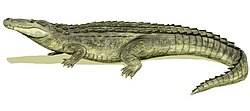| Jacarea | |
|---|---|
 | |
| Yacare caiman, Caiman yacare | |
| Scientific classification | |
| Kingdom: | Animalia |
| Phylum: | Chordata |
| Class: | Reptilia |
| Clade: | Archosauria |
| Order: | Crocodilia |
| Family: | Alligatoridae |
| Subfamily: | Caimaninae |
| Clade: | Jacarea Norell, 1988 |
| Genera | |
Jacarea is a clade of caimans within the subfamily Caimaninae. Jacarea was first named by Norell in 1988 to include the extant species within the genera Caiman and Melanosuchus , while excluding the dwarf caiman genus Paleosuchus . [1] In 1999, Brochu formally cladistically defined Jacarea as the last common ancestor of Caiman latirosris (Broad-snouted caiman), Caiman crocodilus (Spectacled caiman), Caiman yacare (Yacare caiman), Melanosuchus niger (Black caiman), and all its descendants. [1] Molecular DNA phylogenetic studies recover Paleosuchus as outside of Jacarea, although morphological studies are inconsistent. [1]
The cladogram below shows the results of the strict consensus phylogenetic analysis of the 2020 Cicade et al. study: [2]
| Caimaninae |
| ||||||||||||||||||||||||||||||||||||||||||||||||||||||||||||||||||||||||||||||||||||


